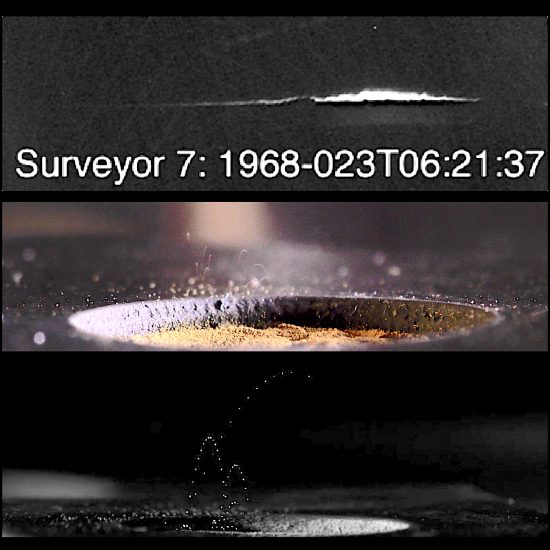
Top: Surveyor 7 image. Middle: particles “smoothed” by dust movement. Bottom: dust particles leap off the table when exposed to laboratory plasmas. Credit: Wang et al/ U.C. Boulder/LASP
Mar 2, 2017
Electricity manifest in many ways.
According to a recent press release, scientists from the University of Colorado think that they know why there is a faint glow on the lunar limb: static electricity. Laboratory experiments confirmed that dust particles, no more than a few microns across, leaped off the table when exposed to plasmas or ultraviolet light. The announcement states that the same electrical activity could be why the Rosetta Cometary Probe found a large quantity of “fluffy” dust particles surrounding Comet 67P/Churyumov–Gerasimenko. Or, why the NEAR-Shoemaker satellite found “ponds” of dust on Asteroid Eros.
There is a glowing haze sometimes seen 100 kilometers above the Moon’s horizon. It is along-standing mystery as to what causes the haze, since there is no atmosphere on the Moon. However, electric charge differential between the day and night side of the Moon might generate an ionic “wind” flowing from the negatively charged night side into the more positively charged sunlit side.
A negative charge on the bright surface during daylight is moderated by the photoelectric phenomenon, while it tends to build up in the darkness, forming static electricity. The charge variation between the two hemispheres has been measured at more than 1000 volts. That electric field could be the transport mechanism.
Earth is surrounded by a magnetic field that stretches well beyond the Moon’s orbit. It is elongated away from the Sun because its ion stream repels charged plasma within the magnetotail, forming a tadpole-shaped, magnetic shell in space. The Lunar Prospector, launched from Cape Canaveral in 1998, detected a high voltage change as it passed through the magnetotail extending outward from Earth. The magnetotail is actually part of a plasma sheath enveloping the planet. The Moon passes through it once a month during full moon phase; the electric differential was found to occur during that passage.
The movement of the Moon through Earth’s ionized plasma affects materials in the lunar regolith. Electrons accumulate, producing a negative charge on the ultra-fine dust particles, causing them to repel each other and drift off the surface.
Earth’s plasma sheet changes shape and power as it is bombarded by electricity from the Sun. It is sometimes described as a “flag waving” because of some periodicity in the field. This means that the Moon does not simply pass through the magnetotail once and briefly, but that electric charges will brush the surface several times during each monthly encounter.
Electricity exists in space and its effects are varied, depending on the environment. Levitating dust and the Moon’s faint glow are most likely because it has no atmosphere, so electric charges have greater impetus.
Stephen Smith
Hat tip to William Thompson












